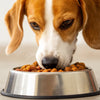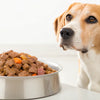Do Dogs Get Water from Wet Food? Exploring Hydration in Our Furry Friends
- Houndsy
Table of Contents
- Introduction
- The Water Content of Wet Dog Food
- Benefits of Wet Dog Food
- Potential Drawbacks of Wet Dog Food
- Dry Dog Food: A Comparison
- How to Ensure Proper Hydration
- Conclusion
Introduction
Picture this: you’re leisurely watching your dog enjoy their meal, but you notice something curious: they’re hardly touching their water bowl. If you’ve found yourself wondering why your dog seems to drink less when eating wet food, you're not alone. Research indicates that dogs eating a wet food diet often consume significantly less water compared to their kibble-loving counterparts. But what’s the connection?
The truth lies in the water content of wet dog food, which can range from a refreshing 70% to as high as 85%. This high moisture content raises an important question: do dogs actually get sufficient hydration from wet food alone, or should we be more vigilant about monitoring their water intake?
In this blog post, we’re diving deep into the fascinating world of canine hydration and wet food. We’ll discuss how much water is present in these meals, their implications for your dog’s health, the benefits and drawbacks of wet versus dry food, and practical ways to ensure our furry companions stay hydrated. Our aim is to help you make informed choices that enhance your dog's nutrition and overall wellbeing. By the end of this article, you’ll not only have a clearer understanding of the relationship between wet food and hydration but also discover how our flagship product, the Houndsy Kibble Dispenser, can elevate your dog-feeding experience.
The Water Content of Wet Dog Food
Wet dog food, often packaged in cans or pouches, is praised for its palatability and high moisture content. But what does this mean for your pet's hydration needs?
Understanding the Composition
-
High Water Content: Wet dog food typically contains between 70% to 85% water. This is one of the key reasons why many pet owners opt for wet food; it assists in keeping dogs hydrated, particularly those who struggle to drink enough from a bowl.
-
Nutritional Balance: While wet dog food is moisture-rich, it is also designed to provide essential nutrients including proteins, fats, and vitamins. However, the quality of ingredients can fluctuate between brands, so it’s crucial to select products tailored to your dog’s dietary requirements.
Implications for Hydration
-
Reduced Water Intake: A noticeable observation among pet owners is the reduction in their dog's overall water consumption when shifting to wet food. Dogs on such a diet may drink significantly less water, leading to potential concerns around dehydration, especially in hot weather or for highly active dogs.
-
Monitoring Hydration: As responsible pet owners, it's our duty to keep an eye on our furry friends’ hydration levels, no matter what food they’re eating. Signs of dehydration may include dry gums, lethargy, and excessive panting. Regular check-ups with a veterinarian can help evaluate hydration status, especially for dogs on a wet food diet.
Benefits of Wet Dog Food
Wet dog food has numerous advantages that can contribute positively to a dog's eating experience and health.
Enhanced Palatability
One of the main reasons pet owners gravitate toward wet food is its flavor. The moisture and aroma make it incredibly appealing to dogs, particularly those that are finicky eaters or have a reduced appetite, such as older dogs or those recovering from illness.
Ease of Consumption
Wet food presents itself as easier for dogs to chew and digest compared to dry kibble, making it a great choice for puppies, senior dogs, or pets with dental issues. The softness and moisture can also aid in their hydration efforts.
Nutrient Density
Despite its high water content, wet dog food is often made with quality ingredients rich in nutrients. This nutrient density can be beneficial for dogs requiring a high-energy diet, such as working or active breeds.
Potential Drawbacks of Wet Dog Food
While wet dog food has its merits, there are several aspects to consider as well.
Cost
Wet food tends to be more expensive than dry kibble. If you’re working within a budget, it may not be feasible to feed wet food exclusively; however, using it to supplement dry food can enhance both flavor and moisture.
Shelf Life
Once opened, wet dog food has a shorter shelf life than dry options. It's vital to store any leftover portions correctly to prevent spoilage. Dogs should not eat expired food, so keeping an eye on expiration dates is essential.
Dental Health
Wet food lacks the crunchy texture of dry kibble, which can help combat plaque and tartar buildup on dogs’ teeth. If your dog primarily eats wet food, integrating dental chews or care into their routine is an excellent way to maintain their oral health.
Dry Dog Food: A Comparison
Now that we have an idea of the pros and cons of wet dog food, let’s compare it to dry dog food.
Water Content
- Dry Dog Food: Contains approximately 10% to 20% moisture. Dogs consuming this type of food will typically need to drink more water to meet their hydration needs.
- Wet Dog Food: With a moisture content of around 70% to 85%, wet food significantly reduces the need for dogs to drink additional water.
Nutritional Value
- Both wet and dry dog foods can provide balanced diets, but the nutritional profile depends on the brand and formulation.
- Dry Dog Food: Often calorie-dense and can be specially formulated for specific health benefits such as weight management or dental health.
- Wet Dog Food: Generally higher in proteins and fats, making it ideal for active dogs. However, it does not provide the same dental health benefits as dry kibble.
Storage and Serving
- Dry Dog Food: Easier to store and has a longer shelf life. It can sit out for extended periods without spoiling.
- Wet Dog Food: Requires refrigeration after opened and has a shorter storage life. Proper serving and swift consumption of leftovers are necessary.
How to Ensure Proper Hydration
As pet parents, we play a vital role in maintaining our dogs' hydration, especially if they're on a wet food diet. Here are some effective strategies to ensure your furry friend stays hydrated:
Monitor Water Intake
Keep track of how much water your dog consumes each day. If you notice a significant decrease in their water intake, it might be time to consult with your veterinarian.
Fresh Water Access
Always provide your dog with fresh, clean water in an easily accessible bowl. Some dogs prefer drinking running water, so a pet water fountain can be a worthwhile investment.
Mixing Wet and Dry Food
Combining wet and dry food can give your dog the best of both worlds. The dry kibble assists in maintaining dental health, while wet food ensures hydration and flavor.
Hydration Supplements
If your dog struggles with drinking enough water, consider adding a splash of low-sodium broth to their food or offering dog-safe fruits and vegetables high in water content, such as cucumbers or watermelon.
Consider the Houndsy Kibble Dispenser
Our flagship Houndsy Kibble Dispenser not only simplifies feeding with perfect portion control but also helps your dog eat comfortably at a standing height. Let’s enhance your dog-feeding experience together—discover more about our Kibble Dispenser here.
Conclusion
In conclusion, wet dog food does contain a significant amount of water that can reduce your dog’s overall need for additional drinking. However, it’s crucial to monitor your pet's hydration and overall health, as wet food may not meet every dog’s hydration needs under all circumstances. Understanding both the benefits and drawbacks of wet and dry dog foods will empower you to make informed choices that cater to your dog's specific needs and lifestyle.
Reflecting on your dog’s diet and hydration habits is key to ensuring a healthier, happier life for your furry friend. Whether you choose wet food, dry kibble, or a combination, the ultimate goal is to keep your dogs hydrated and nourished. So, let’s take a proactive approach to their care by providing balanced nutrition and fostering healthy hydration habits.
FAQ
Q: Does wet dog food contain enough moisture for my dog?
A: Yes, wet dog food typically contains 70% to 85% moisture, which can contribute to your dog’s hydration needs. However, it's essential to monitor their water intake and consult with your veterinarian if you have concerns.
Q: Will my dog drink less water if I feed them wet food?
A: Many dogs do drink less water when consuming wet food because the moisture in the food fulfills a portion of their hydration needs.
Q: Can I feed my dog both wet and dry food?
A: Absolutely! Mixing wet and dry food can provide a well-rounded diet, enhance flavor, and ensure proper hydration while supporting dental health.
Q: How can I encourage my dog to drink more water?
A: Provide fresh, clean water daily, consider using a pet water fountain, and mix in low-sodium broth to entice them to drink more.
Q: What should I do if my dog refuses to drink water?
A: If your dog isn’t drinking enough water, watch for any signs of dehydration like lethargy or dry gums, and consult your veterinarian for guidance on improving their hydration habits.
Explore the Houndsy Kibble Dispenser to enrich your dog-feeding routine and ensure your pet receives the nutrition and hydration they need! Check it out here.













